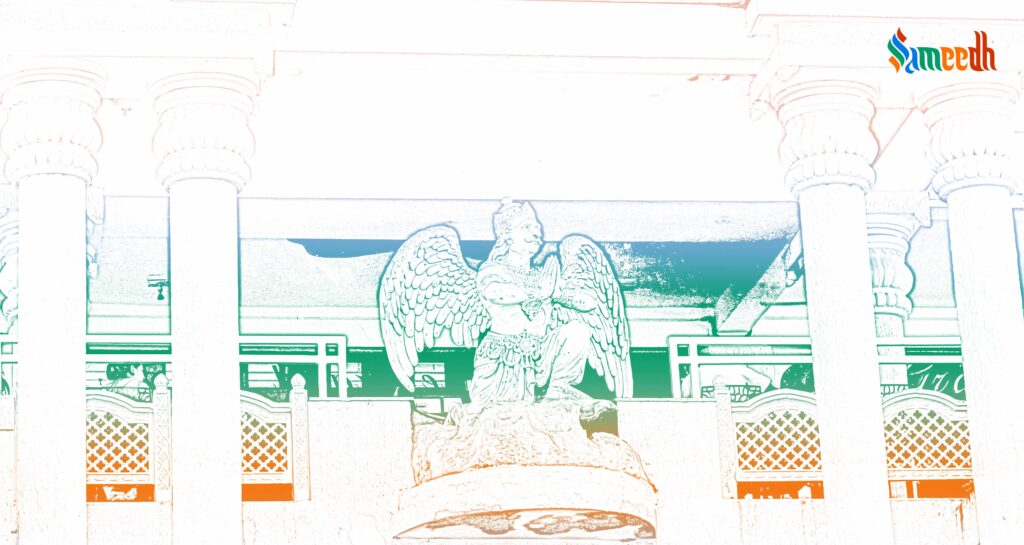Garud is traditionally shown as a powerful warrior with a golden, luminous body, a white face, crimson wings, beak and a crown on his head. This ancient deity is said to have a massive form, huge enough to cover the Sun.

Garud is an Updevta, a heavenly entity and is represented as Bhagwan Vishnu’s vahana (ride) in Sanatan Dharm. Garud is traditionally shown as a powerful warrior with a golden, luminous body, a white face, crimson wings, eagle’s beak and a crown on his head. This ancient deity is said to have a massive form, huge enough to cover the Sun.
Garud is commonly regarded as an eternal and vowed rival of the Naags, descendants of the serpent race; it is thought that Garud only consumed snakes. This action is related to that of the Eagles found in India. The picture of Garud is frequently donned as a pendant or bracelet to protect the person against snake bites and poison. In fact, Garud Vidya is a mantra that is normally used as a curative measure to alleviate the ravages of snake poison as well as to eradicate all forms of evil from the victim’s body.
Garud is usually portrayed with the Adisesha serpent adorned on his left wrist and the serpent Gulik on his right wrist. Vasuki, the mighty serpent, wraps himself to form a sacred thread. Takshak, the cobra, wears a belt around his waist. As a necklace, he bears the serpent Karkotaka. Padma and Mahapadma, two snakes, are also his earrings. Shankachuda, the serpent, drapes his hair like a crown.
Bhagwan Shree Krishna defines himself as mighty and omnipresent in the Bhagavad Gita, while on the battlefield of Kurukshetra. HE says, “I am the avatar of Garud, the son of Vinata. The Saam Ved is regarded to have originated from Garud’s fluttering wings. The two branches of the Saam Ved known as Brihat and Rathantara are regarded to represent the two wings of this heavenly, eternal king of all Divine Vahans. To soothe and relax his Bhagwan Vishnu, Garud vibrated the Samved. Vishnu Rath, Suparna, Khageshwara, Nagantaka, Kamayusha, Gaganeshwara, Chirada, Kashyapi, Vainateya, Sitanana, and Tarkshya etc, have all been titles given to Garuda.
The Mahabharat has defined Garud’s conception story in detail. According to this magnificent epic, Garud originally emerged as a blinding light produced by a powerful flame, which could only be compared to the celestial firestorm which consumes the whole universe at the end of every cycle. The Gods approached Garud and pleaded for compassion, terrified by the sight. Garud quickly responded to their request, and reduced its form and magnitude.
Garud is not only revered in Sanatan Dharm but Buddhism as well. Likewise, it is worshipped in India, Thailand, Indonesia and Mongolia. The Garud is also the Indonesian and Thai national emblem. The Indonesian Garud is represented in the form similar to that of a hawk, whereas the Thai Garud is depicted in the traditional manner. The motif of Garuda is adopted as a military insignia in India. There is an exclusive unit in the Indian Air Force called ‘The Garud Commando Force’ that excels in executing strikes behind enemy territory. The mighty Garud is also used as an insignia by the Indian Army’s Brigade of the Guards.
Garud has become the National Emblem of Thailand and its pictures and statues can be found in many Buddhist monasteries around Thailand. Khangarid is claimed to be a mountain spirit from the Bodg Khan Uul Mountain ranges who embraced Buddhism during his journey on the Earth. He is now thought to have become a symbol of integrity and bravery ever since it is believed to be protecting the mountain range. The Mongolian soccer team has been named as ‘Khangarid’ after the mighty Garud.